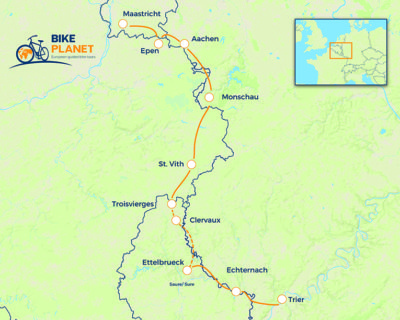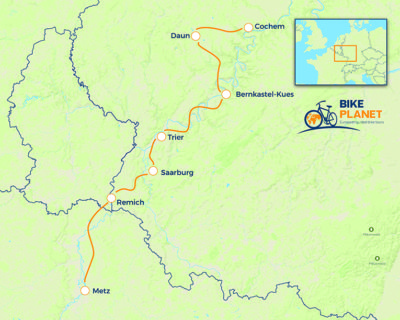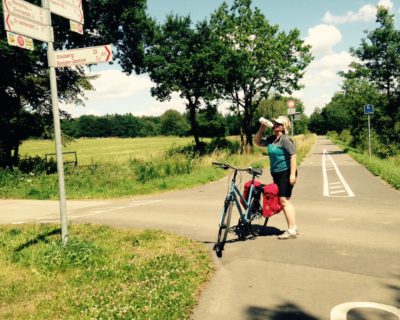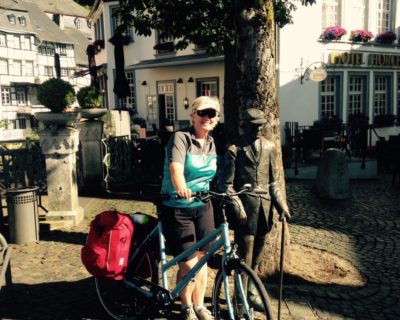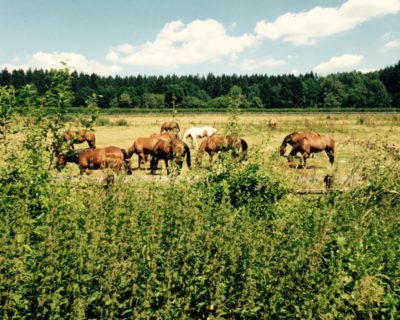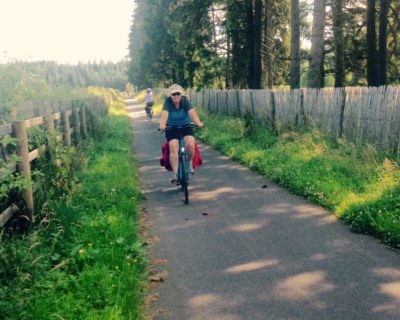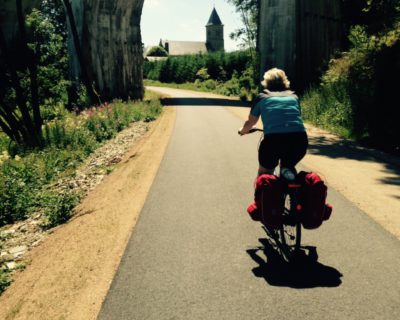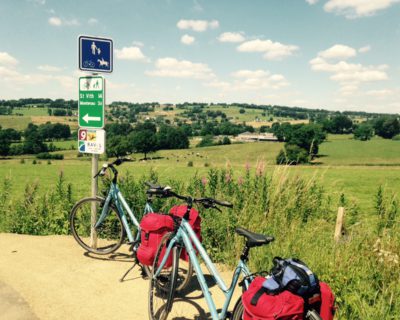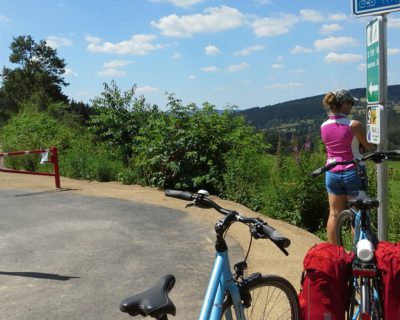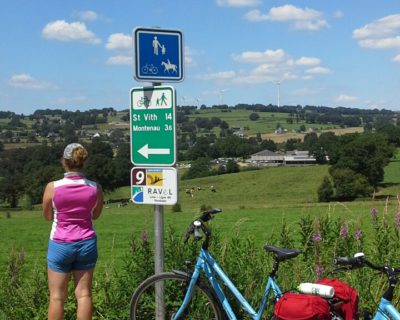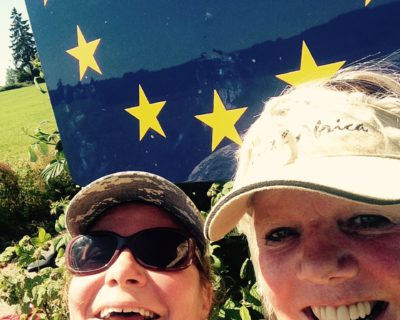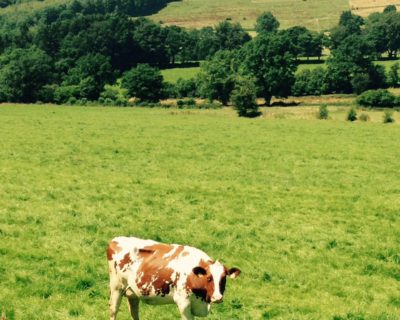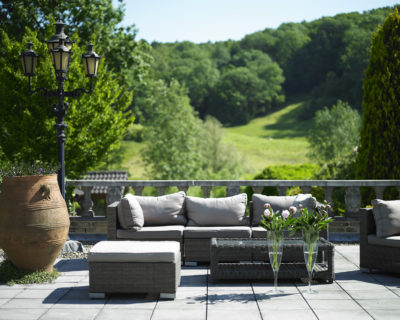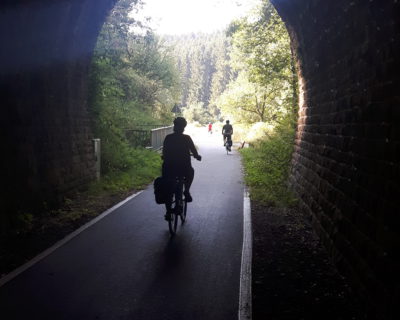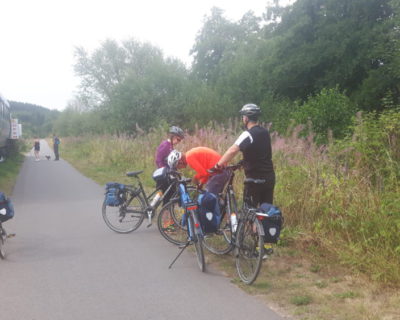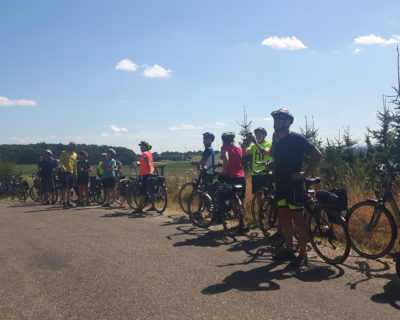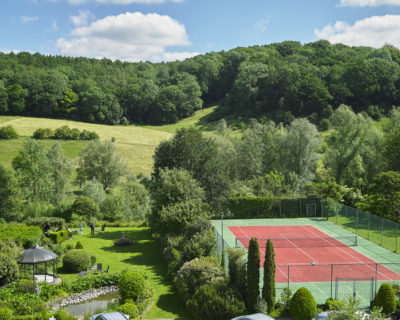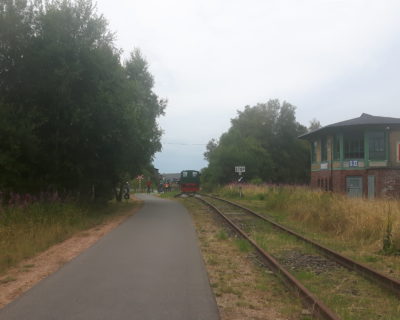Visit 5 Countries on Rails to Trail and Moselle River Bikepath
Chapter 1 of a Cycling Holiday Europe: A cyclists dream for 127 kilometres on a little-known route called the Fenway through the forest. We ride on perfectly paved bike paths in Holland, peddling south into Germany, Belgium, Luxembourg, and Germany. The landscape is dotted with ancient abbeys, tidy villages with their whitewashed brick and half-timbered homes. We hopscotch along borders visiting two Imperial Cities (Aachen and Trier). With its lush forests and clean rivers, this region oozes abundance. The route meanders through high moor and grassland terrain, famous the world over for its local cheeses, cured meats and grains that flavour rich Belgian ales. Trailside cafés serve warm waffles with sweet toppings. Of course, sampling local specialities is what we do best.
Every day we bike through history. The Romans were firmly entrenched here, evidenced by fort ruins, bridges, complex bathhouses, lead and copper mines, and a 130km aqua-duct supplying fresh water to troops on the Rhine River. Later, these woods were the favoured hunting grounds of 9th-century Carolingian emperors. A motherlode of iron and coal made the region a key player in steel manufacturing during the Industrial Revolution. The many markers and memorials remind passers-by of both the destruction and liberation by Allied Forces during the Battle of the Bulge. This is a destination you won’t find on your own. It’s tucked away, straddling borders you’d never know were there…a place was mostly forgotten in the mists of time, a hidden gem in the heart of old Europe.
On Saturday we travel by train from Trier to Metz with the guides. Luggage will be transported for us.
Chapter 2: The Moselle Bikepath: The river with 3 names! Is it Mosel, Moselle or Musel?
That depends on where you are on the river as it forms a natural border with three countries we visit: Germany, France, and Luxembourg. It’s a bike and barge dream-come-true. Paved bike paths, well-marked signage and easy cycling along the Rhine’s largest tributary. Medieval market squares, half-timbered villages, gothic cathedrals and castle ruins. Wunderbar and Fantastique are the words to know!
We follow the breadcrumbs of history. The Romans “civilized” this “barbaric” region bringing their culture and the first grapevines. Little did they know at the time of Julius Cesar that this river valley would blossom into a Riesling drinkers’ paradise. On both sides of the river, the precisely-tended vineyards hug the steep slopes. We promise you the ride of a lifetime with lots of sampling along the way.
We meet up in Metz, one of the last Roman city’s to fall to Atilla the Hun and ancestral home of the Merovingian Dynasty. Metz has great architecture from the centuries and a Gothic cathedral that took 300 years to build.
We start biking through the Lorraine region, the birthplace of French military heroine Joan of Arc. Ooh-la-la the food out here! Those wonderful pieces of bread, Quiche Lorraine, delicate Madaleine cookies and golden Mirabelle plums you’ll find in jams, tarts and a sweet liqueur—the nectar of Gods.
Onto Luxembourg, the only Grand Duchy in Europe. Its strategic position between two superpowers made it a hotly contested area to control over the ages. If you know a little French and German, you’ll understand their mother tongue—a rich soup of both languages in one pot.
And then: Germany! The lead city on this trip is Trier. Ever heard of it? You’re not the only one. Its hey-day was around the 2nd century AD. Known as Roma Segunda at the time, Trier was an Imperial Roman city. Kind of a big deal when Constantine the Great ruled from here. You will see the remnants of this glorious past in Germany’s oldest cathedral, amphitheatre, the emperor’s throne hall and famous “black gate,” the blackened remains of the ancient city wall.
Further downstream, we get to the heart of the Moselle Valley, with its picture-perfect little towns with hundreds of vineyards and wineries. Gently cycling along the Riverside, we reach our final destination at the feet of the Reichsburg of Cochem.
E-bikes Available
Even though this tour is considered easy, the 2% grade uphill for part of the ride does require some leg and lung effort. If you do not like the word “hill”, please look at our other easy bike tours OR: hire an E-bike!
E-bikes are a great way to do this tour without worrying about the effort it might take. E-bikes are trendy in Europe! They make biking as easy as you like it to be, still giving you the exercise and experience you are looking for. The type of e-bikes we use is supporting you a bit, or more, or a lot. You choose, and you still pedalling! It stops when you stop! Save and easy. If you only think of hiring one because of the hills, you might hire one just for the first part of this tour.
Read more
Day-to-day
-
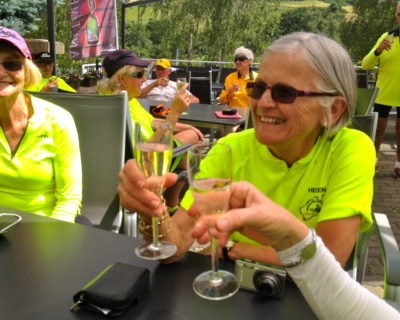
Welcome in Limburg, in the south of the Netherlands
In the hills of Limburg, in a old village close to the Belgium and German borders, we will welcome you in a little hotel. This will be your home for the first 3 nights and from here we will go biking and discovering. But not today, let’s settle down first, have a nice drink on the terrasse and enjoy the scenery and the local hospitality. We will meet up and have a great dinner here.
-
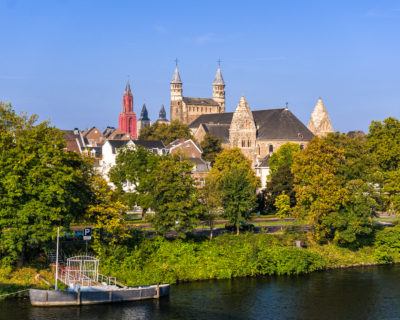
Slenaken (NL) - Maastricht (NL)
Spanish and Roman ruins, elegant French and Belgian touches in the food, architecture and manners. This is the exotic Dutch south. Our bike ride weaves through rolling countryside dotted with castles and breweries… Never fear! After visiting the impressive Holland/American WWII cemetery in Margraten, we follow an easy route to the region’s capital city Maastricht, an ancient and important bridge crossing for getting food and grains from France to the Roman garrisons on the Rhine, the eastern frontier of the empire. Today, Maastricht is lively, international and buzzing with university students. The Maastricht Treaty made the city known in our times as the birthplace of the European Union, European citizenship, and the Euro currency. Take time to explore the beautiful square surrounded by grand cafés, shops, museums and a pair of magnificent churches. The cozy streets and alleys form a medieval labyrinth atop which Sint Pieter fortress crowns the city’s medieval defense system, linked via an underground network of tunnels. The best place to try spicy Indonesian food (outside of Sri Lanka) is in Holland thanks to their seafaring and spice trading routes in the East Indies. “Rijsttafel” (a selection of spicy dishes served with rice) is a must try before leaving.
-
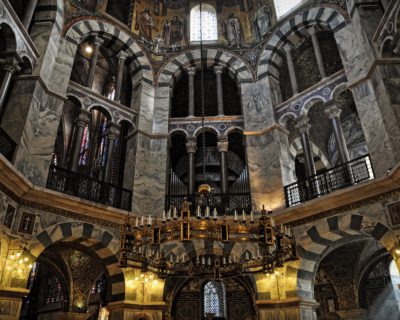
Slenaken (NL) - Aachen (D)
After a hearty Dutch breakfast, we saddle up and follow the emperor’s road to Aachen, Germany’s westernmost city and former Imperial Residence of the Carolingian Dynasty. It was the heart and soul of the medieval European world, the home of Charlemagne and his court in the 9th century. Both French and German cultures trace their beginnings back to him. For 600 years after, 30 German Kings and 12 Queens were coronated in the cathedral Charlemagne built in 796, now a UNESCO world heritage site. His royal remains are interred here and it has been an important pilgrimage destination on the Road to Santiago de Compostela. Aachen is also a famous German spa town. Roman legionnaires soaked their battle-weary bones in the 30 hot springs that bubble up—heated by volcanic activity not far beneath the earth’s crust; medieval monks and kings all took the waters here. The modern-day spa is a topnotch bathing facility and highly recommended. The gothic Rathouse (town hall) is also worth a visit with its 50 life-size rulers guarding the facade. If you stop for a coffee at Café zum Mohren, you’ll have historic views of centuries in one glance…the medieval cathedral and ancient Roman ruins, not to mention the best homemade ice cream cakes in all of Germany. Not to be missed!
-
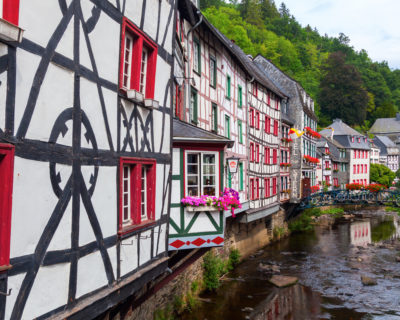
Aachen (D) - Monschau (D)
Today we start the 127km Fen-Railway bike path. This 1882 industrial line was built to transport iron ore and coal to the steel works in Aachen. A hundred years later, it was converted to a rails-to-trails. Crossing viaducts and tunnels, we cycle alongside various rail signal installations and huge water pumps that once filled thirsty steam locomotives. What a thrill for historic train enthusiasts. We climb at a 2% grade through a forest you can imagine Hansel and Gretel would have played—and gotten lost. The air is piney fresh along the German-Belgian border through towns like Roentgen—first to be liberated by American troops at the end of WWII. We descend into a narrow forested valley to Monschau, arriving at our historic hotel, a half-timbered beauty brimming with flower boxes. Thanks to the river that flows through the center, mills generated cloth fabric in the 1700s and the town grew rich. This pretty German village looks too “Disney” to be real, but it is. Imagine meandering cobblestone streets, craggy cliffs, a 12th century castle and outdoor terraces overlooking the river. It’s like finding a treasure when you least expect it.
-
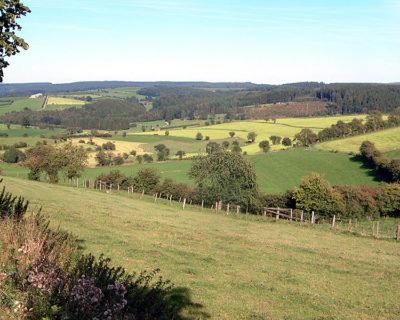
Monschau (D) - St. Vith (B)
Today we ride through the high fen (moor) straddling the Belgian-German border heading south. It is a mystical landscape, a place for poets, daydreamers, and cyclists… Due to a unique variety of grasses, heathers and birdlife, this watery world of springs is not only a National Park but also a massive watershed for two major rivers including the Maas and the Rhine. We pedal through the peaceful Belgian countryside into sleepy villages with steaming waffles tempting you to stop. Smell the roses, they’re blooming! The views sweep across rolling green pastures as far as the eye can see with horse farms and grazing cattle. This is farm country at its best. If you happen to catch a whiff of bacon, it’s because the finest smoked meats are cured in the former railway station in Montenau along our route. St. Vith is our home for the night. After centuries as a market town and then important railway junction, you’ll notice the town appears new, and it is. On Christmas 1944, St Vith was obliterated, the fate of so many border towns throughout the ages. It’s the tiny part of eastern Belgium that speaks German. Find a café and order steamed mussels and a local Belgian ale. You earned it!
-
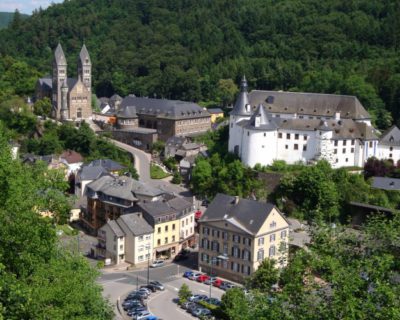
St Vith (B) - Clervaux (L)
The morning ride promises a good chance of wild animal sightings…herons, field rabbits, falcons, red stags and wild boar. Before you know it after a few more clicks in Belgium, we’re already in Luxembourg, the world’s only Grand Duchy. A country half the size of Rhode Island. The language is a mélange of her two powerful neighbors French and Germany, resulting in a unique language called Luxembourgish. After a nice lunch in Troisvierges, there’s a side trip to visit the Battle of the Bulge War Museum in Bastogne, Belgium. To prepare for this trip, we recommend Monuments Men and the HBO miniseries, Band of Brothers.
-
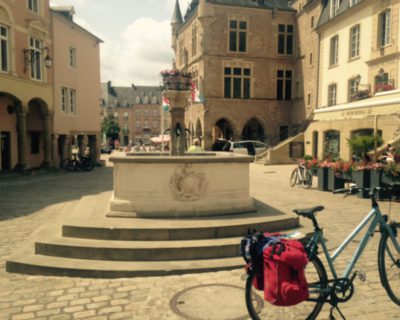
Clervaux (L) - Trier area (D)
A private bus takes us to Ettelbrück in Luxembourg, where we enjoy easy cycling along the Sauer River, our final leg, before reaching the vineyard-clad slopes of the lovely Moselle River. First, we pass Diekirch, home of the famous Luxemburg Beer. The Luxembourgers love their riverside campgrounds! We arrive for lunch in the precious town of Echternach, and you can feel a certain presence the minute you step foot inside the oldest town in Luxembourg. The town developed around the Benedictine monastery which Willibrord, the Patron Saint of Luxembourg built in 698 AD. He is the only saint to be buried in this country, and his remains lie here. Another important pilgrimage stop for Catholics. The monastery was renowned for its Scriptorium, which produced priceless decorative manuscripts. Remnants of the largest Roman villa ruins north of the Alps are on display for us to investigate. Enjoy a leisurely lunch at the town square. By midday we arrive at the German Mosel River, famous for Riesling wines, dramatic scenery and Imperial Trier, the ancient Roman city where Constantine the Great ruled during the late Classical period.
-
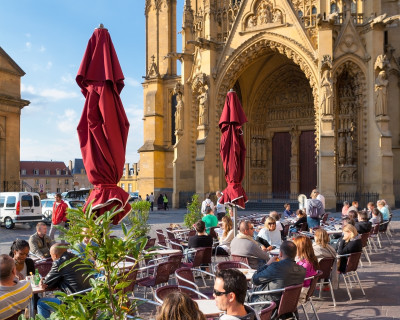
NO biking today: Transfer to Metz by train
We get on the train to travel to Metz, an ancient city strategically situated on a Roman trading route. St.Etienne Cathedral is the 3rd largest gothic church in France with flying buttresses and Marc Chagall stained glass windows. Metz is full of stunning architecture, flowers and great cafes.
After all this sightseeing you will be more than welcome at our comfortable little floating hotel the IRIS. Dinner awaits us, and we meet other travellers and the crew for this week.
-
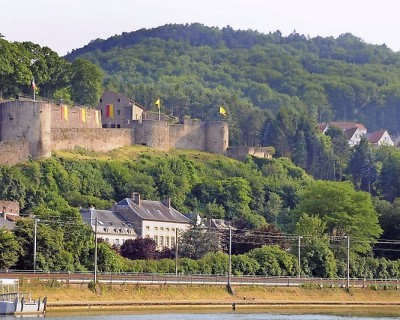
Metz (Fr) - Remich (L)
Today we leave France behind and look to Luxembourgh and Germany. For centuries, this territory has been French than German.German then French. You get the idea. . Thionville was the center of the steel industry until the 1980s. That might sound modern and industrial, but the city is ancient. The historic center shows us the medieval ramparts, lovely gardens, old streets and St.Maximin basilica which houses one of the finest organs in the world. Thionville is also part of the infamous Maginot line, an enormous defense network of forts and bunkers built between World Wars against the Germans. It failed miserably—one of the worst military strategies ever conceived. After spending millions on it, the Germans simply marched around in their Blitzkrieg warfare style. We pass the fortress high up on the rocky outcrop, one of the palaces inhabited by the powerful Dukes of Lorraine. The route is lovely French countryside, riparian landscapes and tiny villages. We ride past wheat fields and pastures of white cows (charolais) praised for their strength as draft animals and excellent meat! We end our tour in Remich, on the Luxembourgian side of the Mosel, Germany on the other.
-
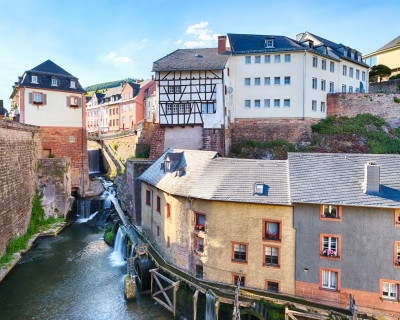
Remich (L) - Saarburg (D)
We take you to a hidden gem. It’s a great story of historic preservation…imagine you’re a farmer in 1852 and you’re tilling your field. Suddenly, these colorful square pieces start appearing in the plough sod. What that farmer soon discovered was pieces that belonged in a tiled mosaic floor—dating back 1,600 years! The tile floor which lies in its original place, was once the centerpiece in a palatial Roman villa. The scene (in 3 million individual tile pieces) reveals scenes from gladiator games in the amphitheater. It’s breathtaking and original.
We pedal toward Luxembourg, the tiny nation about the size of Rhode Island. Don’t let size fool you, Luxembourg is an important finance center and EU administrative city. We have a stop in Schengen were the Europian Union created the Schengen Agreement, enabling Europian free traffic.
Our path leads us to a place that’s a throw-back in time. The name Saarburg means “fortress on the river Saar” to give you a hint of what to expect there. The ruins date back to the 10th century, a summer palace for the Archbishops of Trier—powerful men and power brokers in the Holy Roman Empire. We love Saarburg. There’s a natural, steep drop between the “upper and lower” towns, but they’re connect by a high waterfall. Town fathers back in the 1300s diverted a local river to run through the center so they’d have access to water to fight fires quickly and have continual energy to run their mills. All of this is well-preserved in the 17th-18th century homes that cling to the hillside. It’s medieval German engineering at its best.
-
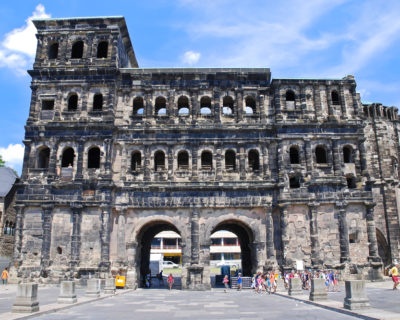
Saarburg (D) - Trier (D)
We bike on to Trier, leaving the Saar river and following the Mosel again, into this lively university town, powerful Arch-diocese, and Imperial Residence of Constantine the Great. All roads lead to Rome as they say, but in this case our road leads to Trier, the 2nd Rome in the 3rd century. The history is fascinating. More than you’d expect on the sleepy Mosel. Great museums. Superb shopping. A gem of a city.
-
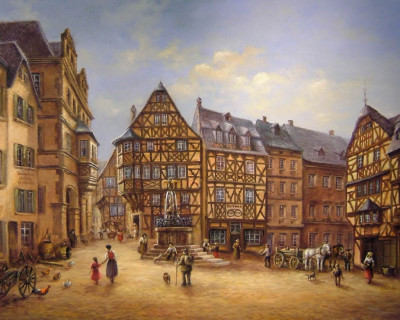
Trier (D) - Bernkastel (D)
The wide river valley is now showing us vineyards as far as the eye can see. We pass the heavy-hitters in the wine world: Trittenheim lies in a sharp hairpin turn on the river surrounded by mountains coated with grapes. The chapel in the vineyard is one of the most photographed on the river. Piesport, Brauneberg and finally Bernkastel, the darling of the famed middle Mosel. This is Valhalla for Riesling aficionados. A good size village with great shopping, wine bars and ice cream. One of the prettiest town squares with timber-frame buildings dating back to the 1400s! The castle ruins on the hill are base-lit at night. An evening stroll along the river is a must…words can’t describe the feeling of Old Europe.
-
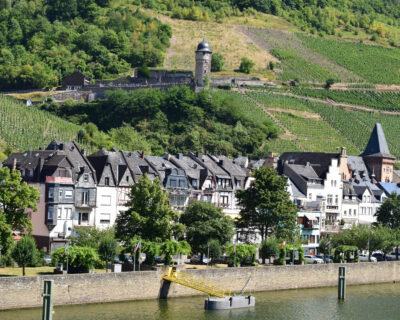
Bernkastel to Zell
We are now in the heart of the wine-producing Moselle Valley, cycling through the vineyards.
Our bike journey follows the river upstream, passing the steepest vineyards in the world to arrive in Zell, a beautiful hamlet where the river slices through slate mountains in dramatic oxbows and S turns. Zeller Schwarze Katz (black cat) is a legendary Mosel Wine.
-
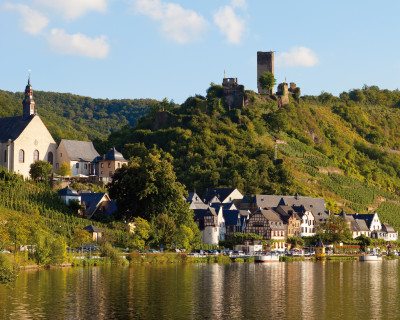
Zell - Cochem (D)
Our last day has a lot of Mosel Beauty to show: first, Traben-Trarbach; this town features world-class Art Nouveau architecture that proves its great importance in the international wine trade during the 19th century.
And then the Sleeping Beauty on the Mosel. It’s a precious medieval village called Beilstein. It has been the backdrop for many German films. You will have the chance to see the revered and rare relic, the Black Madonna, in the chapel of the Carmelite Monastery overlooking the valley. Great photo ops here. After the visit, our journey follows the river downstream, passing a last lock and onwards to the IRIS, docking in Cochem, a bustling and characteristic Mosel town with steep wine-clad mountains, wooded hills, an impressive castle and a picturesque square with beautiful timber-framed houses and cafes. You can visit the castle, have a glass of local wine, or both!
-
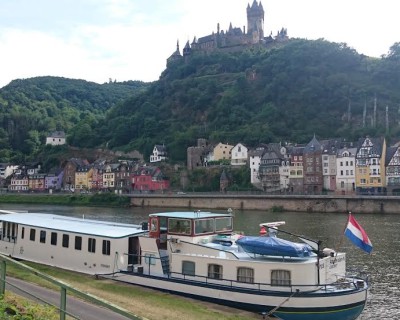
Cochem (D)
Time to say goodbye, your guided tour ends after breakfast. You can leave your luggage on board untill lunchtime, and visit Cochem a bit more.
Accommodations
-
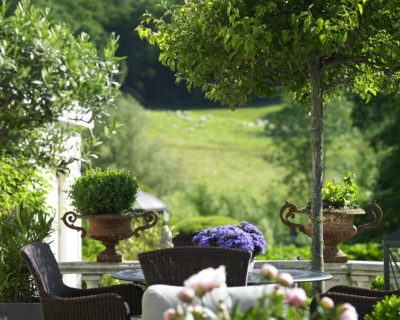
Our first three nights in Limburg (NL)
NEW in 2019: our luxurious family run hotel in the little village of Slenaken! Offers more to relax&enjoy your holiday. Indoor swimming pool and jacuzzi, outdoor tenniscourt, fitness room, strolling through the village or just enjoying the quiet terraces…..it’s there to enjoy. Rooms are very pleasant and the chef will serve a nice dinner every night we stay here.
-
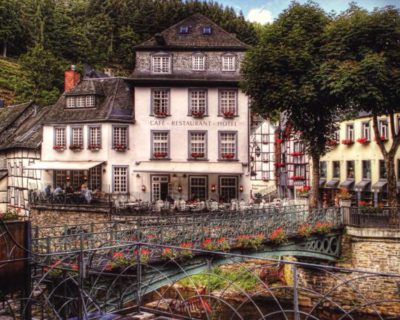
in the centre of beautiful Monschau
This hotel is a little historic gem, so we have to accept some stairs to get to our rooms. It’s on the nicest spot of the village, and if you like you can enjoy your breakfast on the terrace next to the river that runs through Monschau.
-
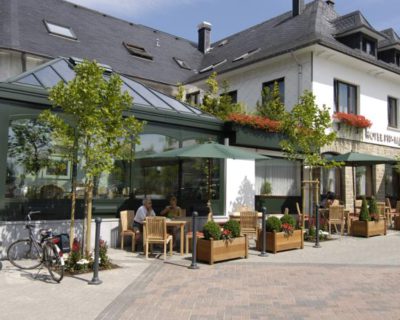
in the heart of St. Vith
This little town has a lot of shops and in the centre we will find our cosy, well renovated and just right for us town-hotel. We will have a nice diner here.
-

A grand hotel in Clervaux, having a swim?
As an exception to our preferences, this night we will stay in a grand hotel. Luxury and Wellness await us. We’ll have an early check in here, so you can enjoy the facilities of the hotel.
After lunch it’s yours and diner is on your own this night.
-
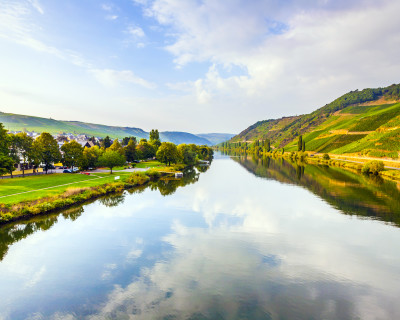
on the banks of the Moselle
Last but not least we will stay in the Trier (area) and enjoy a farewell diner.
-
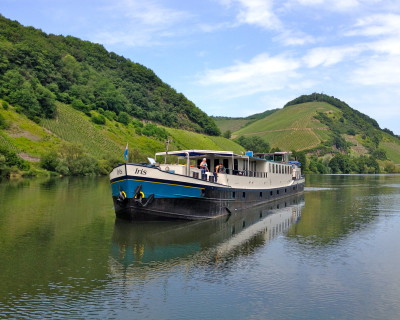
Our floating and sailing hotel: the IRIS
One of the best: our comfort plus barge IRIS, sailing since 2005. Fully air-conditioned, lovely front sundeck, lounge and dining-area and self-service Bar. Delicious 3 course dinners and packed lunches. Lots of options at Breakfast.
If you do not feel like cycling you are welcome to stay on board and have a private cruise
-
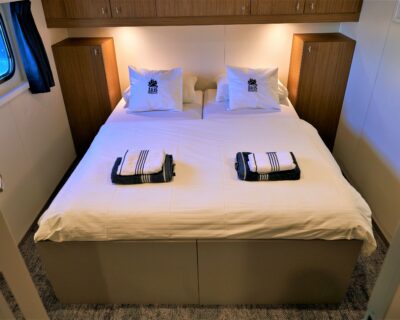
Cabins with a double bed
Your air-conditioned cabin has two comfortable beds, joint together, and lots of storage (for such a small cabin!). Ensuite your private bathroom
-
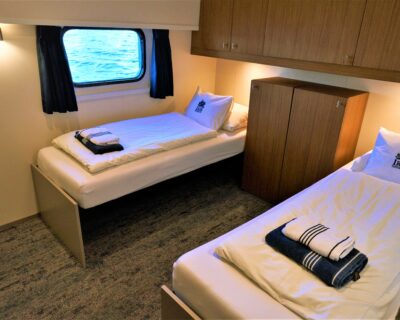
Cabins with separate beds
The most spacious way to use the cabin is with beds on both sides, so you have space between the beds.
-
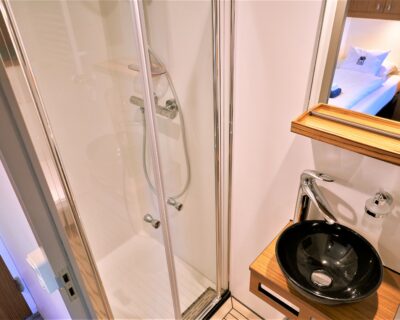
our private bathrooms
refurbished in 2020
-
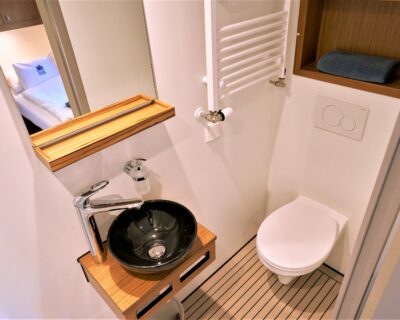
bathroom encore!
refurbished in 2020
-
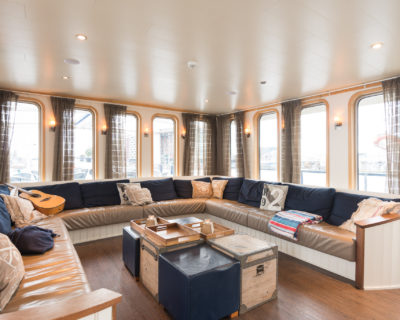
Lounge
Perfect to enjoy a cold beer or glass of Pinot Gris from our self-service Bar
Services in detail:
Your tour is prepared for you in the finest of details.
Our most important feature is the presence of 2 guides/tour managers on your tour. During the first half of the tour, one of the guides is driving the van. On the second part of the tour, both guides are biking with you.
Our rates are based on one person, double occupancy of rooms. Please inquire about the single surcharge.
- Seven nights in hotels in Limburg (area), Monschau, St. Vith, Clervaux and Trier, including breakfast
- Welcome reception and dinner in Slenaken
- 2 x dinner in Slenaken
- 1 x dinner in St. Vith
- Lunch at Trois Vierges
- Entrance and Audio tour WW II Museum in Bastogne.
- Diner in Trier (area)
- All transfers during the tour by train or coach
- 7 nights on passenger barge IRIS including breakfast
- 6 packed lunches on IRIS
- 5 dinners onboard
- Wine tasting
- Helmet, pannier, water bottle
What is not included on this tour:
- Bike rental: Our nice bike is available for 240 euro for 2 weeks.
- E-bike rental: on preorder only: 440 euro for 2 weeks.
- Excursions, Exhibitions
- Entrance fees for museums, monuments, etc.
- Travel and cancellation insurance
- Miscellaneous beverages and expenses on excursions.
- Gratuities for Staff and Guides
- Dinners not mentioned in the description above.
Optional:
Extra night(s)* in the Netherlands can be arranged on demand
*on availability
Considering hiring an E-bike?
Even though this tour is considered easy, the 2% grade uphill for part of the ride does require some leg and lung effort. If you do not like the word “hill”, please look at our other easy bike tours OR: hire an E-bike! You might consider doing this only on the first part of our tour, in the undulating hilly part of this trip.
E-bikes are a great way to do this tour without worrying about the effort it might take. E-bikes are trendy in Europe! They make biking as easy as you like, giving you the exercise and experience you seek. Our e-bike supports you a bit, or more, or a lot. You choose, and you’re still pedalling! It stops when you stop! Save and easy.
The only significant limitation is that an e-bike is heavy, and you must cycle and keep your equilibrium. So for inexperienced novice cyclists: please practice at home, rent an e-bike and try if this will work for you!
